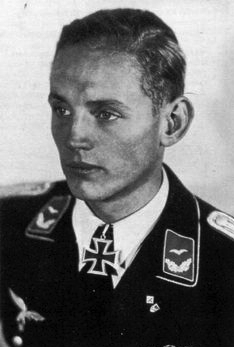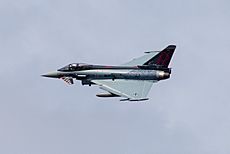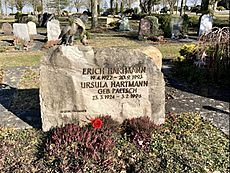Erich Hartmann facts for kids
Quick facts for kids
Erich Hartmann
|
|
|---|---|

Hartmann as a Luftwaffe Leutnant (1942–1944).
|
|
| Native name |
Erich Alfred Hartmann
|
| Nickname(s) | Bubi ("The Kid") Der Schwarze Teufel ("The Black Devil") |
| Born | 19 April 1922 Weissach, Württemberg, Weimar Republic |
| Died | 20 September 1993 (aged 71) Weil im Schönbuch, Germany |
| Buried |
New Cemetery, Weil im Schönbuch
|
| Allegiance | |
| Service/ |
|
| Years of service | 1940–1945 1956–1970 |
| Rank | Major (Wehrmacht) Oberst (Bundeswehr) |
| Unit | JG 52, JG 53 and JG 71 |
| Commands held | I./JG 52 and JG 71 |
| Battles/wars | |
| Awards | Knight's Cross of the Iron Cross with Oak Leaves, Swords and Diamonds |
| Other work | Civilian flight instructor |
Erich Alfred Hartmann (born April 19, 1922 – died September 20, 1993) was a German fighter pilot during World War II. He is known as the most successful flying ace in history. A flying ace is a pilot who shoots down five or more enemy aircraft.
Hartmann flew 1,404 combat missions. He took part in air battles 825 times. He was credited with shooting down 352 Allied aircraft. This included 345 Soviet planes and seven American planes. He flew for the Luftwaffe, which was Germany's air force. During his career, Hartmann had to crash-land his fighter 16 times. This was due to mechanical problems or damage from parts of enemy planes he had shot down. He was never shot down by direct enemy fire.
Before the war, Hartmann was a glider pilot. He joined the Luftwaffe in 1940. He finished his fighter pilot training in 1942. He was sent to Jagdgeschwader 52 (JG 52). This was a skilled fighter wing on the Eastern Front. There, he learned from some of the Luftwaffe's best pilots.
On October 29, 1943, Hartmann received the Knight's Cross of the Iron Cross. This was for destroying 148 enemy aircraft. On March 2, 1944, he got the Oak Leaves to the Knight's Cross for 202 victories. Four months later, he received the Swords for 268 planes shot down. Finally, on August 25, 1944, Hartmann earned the Knight's Cross of the Iron Cross with Oak Leaves, Swords and Diamonds. This was for 301 aerial victories. At that time, it was Germany's highest military award.
Hartmann achieved his 352nd and last victory on May 8, 1945. This was just hours before Germany surrendered. He and the rest of JG 52 surrendered to United States Army forces. They were then handed over to the Red Army (Soviet Union). The Soviets wanted him to join the East German army. He was imprisoned and spent 10 years in Soviet prison camps. He was released in 1955. In 1997, after his death, Russia cleared him of all charges.
In 1956, Hartmann joined the new West German German Air Force. He became the first leader of Jagdgeschwader 71 "Richthofen." He retired in 1970. This was because he disagreed with using the Lockheed F-104 Starfighter jet due to safety worries. After his military career, he became a civilian flight instructor. Hartmann passed away on September 20, 1993, at age 71.
Contents
Early Life and Flight Training
Erich Hartmann was born on April 19, 1922, in Weissach, Germany. His father was a doctor. Due to economic problems after World War I, his family moved to China. Erich spent his early childhood there. In 1928, the family returned to Germany because of the Chinese Civil War. Erich's younger brother, Alfred, also joined the Luftwaffe. He was a gunner in North Africa and became a prisoner of war.
Hartmann went to different schools in Germany. He met his future wife, Ursula "Usch" Paetsch, at one of these schools.
His flying journey began when he joined the Luftwaffe's glider training program. His mother, one of Germany's first female glider pilots, taught him to fly. In 1936, at age 14, Hartmann became a gliding instructor for the Hitler Youth. By 1937, he had his pilot's license for powered aircraft.
Hartmann started his military flight training on October 1, 1940. He learned to fly the Messerschmitt Bf 109 at a fighter pilot school. His training wasn't always smooth. Once, he did aerobatics in his Bf 109 when he shouldn't have. He was punished with a week of confinement and lost some pay. After this, he learned to "Fly with your head, not with your muscles." He became very good at shooting targets. By the end of his training, he could fly 17 different types of planes.
World War II Combat Missions
In October 1942, Hartmann joined Jagdgeschwader 52 (JG 52). This fighter wing was based on the Eastern Front in the Soviet Union. He flew the Messerschmitt Bf 109G. His first combat flight was on October 14, 1942. He was flying with an experienced pilot, Edmund Roßmann. Hartmann was too eager and broke away from Roßmann. He tried to attack an enemy fighter but missed and almost crashed. He ran out of fuel and had to crash-land. For this, he was made to work with the ground crew for three days.
Hartmann learned from his mistakes. He was then paired with another experienced pilot, Alfred Grislawski. Twenty-two days later, Hartmann got his first victory: an Ilyushin Il-2 Sturmovik. But by the end of 1942, he had only one more victory. It took him time to become a successful fighter pilot.
Improving His Flying Skills
Hartmann's young looks earned him the nickname "Bubi" (meaning "Kid"). His new wingman, Walter Krupinski, often told him to "get in closer." This close-range method was dangerous. On May 25, 1943, Hartmann even collided with a Soviet fighter. But he kept getting better. When Krupinski was away, Hartmann's victories jumped from 17 to 60.
In July 1943, during the Battle of Kursk, Hartmann claimed four victories in one day. The next day, he couldn't stop Krupinski from being shot down and wounded. Hartmann temporarily led his squadron. He started scoring victories regularly. On July 7, he became an "ace-in-a-day" for the first time. This means he shot down five or more planes in one day. He claimed seven victories that day.
By August 1943, his total was 42. But by the end of the month, it had more than doubled. On August 1, he again became an "ace-in-a-day" with five victories. On August 5, he claimed five more. By August 20, he had 90 victories. On September 2, he became the leader of 9./JG 52.
Hartmann felt that Soviet pilots often lacked good equipment. He also thought their planes like the Bell P-39 Airacobra and Hawker Hurricane were not as good as German ones. But German pilots also learned from the Soviets. For example, they learned how to start their planes in the extreme cold of the Russian winter.
Hartmann's Fighting Style
Unlike some other aces, Hartmann was not a master of fancy dogfights. He preferred to sneak up on enemy planes and attack them by surprise. He would wait until he was very close (20 meters or less) before firing. Then he would unleash a short burst of bullets. This method helped him:
- Stay hidden until the last moment.
- Make sure his shots were accurate.
- Save ammunition.
- Prevent the enemy from escaping.
Hartmann's motto was: "See – Decide – Attack – Reverse." This meant: observe the enemy, decide how to attack, make the attack, and then quickly leave the area to plan the next move. His main goal was to survive. If he was attacked, he would use a special maneuver to throw off the attacker. These tactics helped him achieve many victories. By September 20, 1943, he had over 100 victories.
Receiving the Knight's Cross
In August 1943, Hartmann's plane was damaged by debris from an enemy plane. He had to land behind Soviet lines. He pretended to be badly injured. Soviet soldiers put him on a truck. But Hartmann managed to escape and returned to his unit.
On September 20, 1943, Hartmann reached 100 aerial victories. He was the 54th Luftwaffe pilot to do so. On October 29, he received the Knight's Cross of the Iron Cross. By the end of 1943, his total was 159 victories.
In early 1944, Hartmann continued to score many victories. On February 26, he shot down 10 planes, reaching 202 victories. His amazing success made the Luftwaffe High Command check his claims very carefully. An observer even flew with him to watch his performance.
Soviet pilots knew Hartmann's radio call sign, Karaya 1. The Soviet command even offered 10,000 rubles for his capture. Hartmann was nicknamed the Cherniy Chort ("Black Devil"). This was because of his skill and a black tulip design on his plane's nose. However, this design made enemy pilots avoid fighting him. So, Hartmann had the tulip removed. After that, his kill rate went back up.
In March 1944, Hartmann and other top pilots were called to Adolf Hitler's headquarters. Hartmann received the Knight's Cross of the Iron Cross with Oak Leaves.
Diamonds to the Knight's Cross
In April and May 1944, JG 52 fought against the Soviet Crimean Offensive. Hartmann claimed many more victories. On May 8, 1944, JG 52 left the region as the German defense failed. They then fought on the Romanian border.

On May 21, Hartmann fought United States Army Air Forces planes for the first time. He defended the Ploiești oilfields in Romania against North American P-51 Mustang fighters. He claimed one P-51 shot down. Later, during a fight, his plane ran out of fuel and ammunition. He had to bail out. An American P-51 pilot flew close to him as he parachuted down.
On August 17, Hartmann became the top-scoring fighter ace. He passed fellow JG 52 pilot Gerhard Barkhorn, with 274 victories. On August 23, he claimed eight victories. On August 24, 1944, he shot down 11 planes in two missions. This was his best day ever. It brought his total to an amazing 301 victories.
Hartmann became one of only 27 German soldiers in World War II to receive the Diamonds to his Knight's Cross. He met Adolf Hitler to receive the award. Hartmann talked to Hitler about problems with pilot training. Hitler reportedly said that the war was "militarily lost."
After receiving the award, Hartmann took a 10-day leave. He was asked to join a new jet fighter program. But Hartmann chose to stay with JG 52. On September 10, he married Ursula "Usch" Paetsch.
Final Combat Missions
In January 1945, Hartmann became the leader of I. Gruppe of JG 52. He claimed his 350th victory on April 17. His last victory happened on May 8, the last day of the war in Europe. He flew a reconnaissance mission and spotted Soviet forces. He then shot down a Yak-9 fighter.
When he landed, Hartmann learned that Soviet forces were close. So, JG 52 destroyed their planes, including Hartmann's "Karaya One." Hartmann and another pilot were ordered to fly to the British sector to avoid being captured by the Soviets. The rest of JG 52 was ordered to surrender to the Soviets. Hartmann chose to surrender his unit to the US 90th Infantry Division.
Prisoner of War Experience
After being captured, the U.S. Army handed Hartmann and his unit over to the Soviet Union on May 14. This was part of agreements made at the Yalta Conference. He was imprisoned.
Hartmann said the Soviets tried to make him work for them. They asked him to spy on other officers, but he refused. He was put in solitary confinement for ten days. He slept on a concrete floor and was given only bread and water. Hartmann also claimed the Soviets threatened his wife. He went on a hunger strike, but the Soviets force-fed him. He spent 10 years in Soviet prison camps.
Life After the War

During his time as a prisoner, Hartmann's son, Erich-Peter, was born in 1945. Sadly, his son died in 1948 at age three, and Hartmann never saw him. Hartmann later had a daughter, Ursula Isabel, born in 1957.
When Hartmann returned to West Germany, he rejoined the military. He became an officer in the West German Air Force. From 1959 to 1962, he commanded West Germany's first all-jet unit, Jagdgeschwader 71 "Richthofen". This unit first used Canadair Sabres and later Lockheed F-104 Starfighters.
Hartmann also visited the United States to train on U.S. Air Force equipment. He trained at Luke Air Force Base in Arizona.
Hartmann believed the F-104 Starfighter was a dangerous plane. He strongly opposed its use by the Air Force. Many F-104s crashed, and many German pilots died. Hartmann's strong opinions were not popular with his superiors. He was forced to retire early in 1970. From 1971 to 1974, Hartmann worked as a flight instructor.
Erich Hartmann died on September 20, 1993, at age 71. In 2016, his former German Air Force unit, JG 71, honored him. They painted his black tulip design on one of their Eurofighter Typhoon jets.
Summary of His Career
Aerial Victory Claims
Erich Hartmann is credited with 352 aerial victories. He achieved all of these on the Eastern Front. This number includes two claims against American P-51 Mustangs. Some historians note that comparing his claims to enemy loss reports suggests the actual number might be lower.
Awards and Decorations
- Front Flying Clasp of the Luftwaffe in Gold with Pennant "1300"
- Pilot/Observer Badge in Gold with Diamonds (August 25, 1944)
- Eastern Front Medal
- Iron Cross (1939)
- 2nd Class (December 17, 1942)
- 1st Class (March 7, 1943)
- Honour Goblet of the Luftwaffe on September 13, 1943
- German Cross in Gold on October 17, 1943
- Knight's Cross of the Iron Cross with Oak Leaves, Swords and Diamonds
- Knight's Cross on October 29, 1943
- 420th Oak Leaves on March 2, 1944
- 75th Swords on July 2, 1944
- 18th Diamonds on August 25, 1944
Hartmann kept his Knight's Cross hidden from his captors during his time as a prisoner of war. He claimed he had thrown it away. His friend, Hans "Assi" Hahn, managed to hide the medal in a cigar box and brought it back to Germany.
Military Ranks
Hartmann joined the military on October 1, 1940.
Luftwaffe (Wehrmacht)
- April 1, 1942: Leutnant (Second Lieutenant)
- May 1, 1944: Oberleutnant (First Lieutenant)
- September 1, 1944: Hauptmann (Captain)
- May 8, 1945: Major (Major)
Luftwaffe (Bundeswehr)
- December 12, 1960: Oberstleutnant (Lieutenant Colonel)
- July 26, 1967: Oberst (Colonel)
See also
 In Spanish: Erich Hartmann para niños
In Spanish: Erich Hartmann para niños



